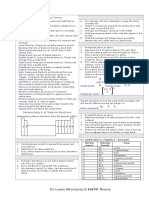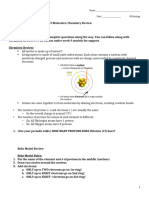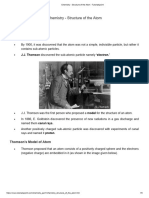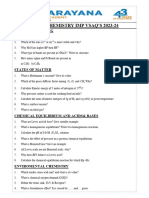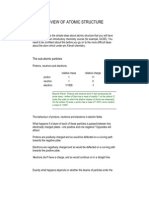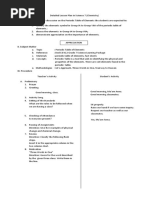The Periodic Table and Atomic Theory: Words To Know
The Periodic Table and Atomic Theory: Words To Know
Uploaded by
friscokid13Copyright:
Available Formats
The Periodic Table and Atomic Theory: Words To Know
The Periodic Table and Atomic Theory: Words To Know
Uploaded by
friscokid13Original Title
Copyright
Available Formats
Share this document
Did you find this document useful?
Is this content inappropriate?
Copyright:
Available Formats
The Periodic Table and Atomic Theory: Words To Know
The Periodic Table and Atomic Theory: Words To Know
Uploaded by
friscokid13Copyright:
Available Formats
2.
3 The Periodic Table and Atomic
Theory
In a Bohr model diagram, electrons are arranged in shells in a specific pattern
around the nucleus. The electrons in the outermost electron shell are called valence
electrons. The number of valence electrons in an atom determines many of its
chemical and physical properties. The atoms of all alkali metals have one valance
electron; an atom of each alkaline earth metal has two valence electrons; and an
atom of each halogen has seven valence electrons. Noble gas atoms have filled
valence shells, which makes them chemically stable. All noble gas elements have
eight valence electrons except helium, which is stable with two valence electrons.
The periodic table is full of patterns. For example, non-metals appear on
Words to Know the right. This is no accident. Patterns occur as a result of regular changes
Bohr model in the structure of the atoms of these elements. Elements with similar
electron shells properties line up in columns because all those elements are similar in the
valence electron arrangement of their electrons.
valence shell One way to show the arrangement of electrons in an atom is with a
Bohr model diagram. A Bohr model diagram shows how many electrons
are in each shell surrounding the nucleus (Figure 2.21). This type of
diagram is named after Niels Bohr (Figure 2.22), the Danish physicist
whose model of the atom you studied in section 1.3. The regions
surrounding the nucleus of an atom are sometimes called electron shells.
The shell nearest the nucleus can hold 0, 1, or 2 electrons. The next two
shells outward can each hold up to 8 electrons. Any remaining electrons
will fill the fourth shell, to a maximum of 18. This pattern of 2, 8, 8, and
18 applies to all atoms, although not all atoms have that many electrons.
first shell up to 2 electrons third shell up to 8 electrons
second shell up to 8 electrons fourth shell up to 18 electrons
nucleus 2e 8e 8e 18e
Figure 2.22 Niels Bohr
Figure 2.21 A Bohr model showing electron shells
64 MHR Unit 1 Atoms, Elements, and Compounds
2-3A Looking for Patterns in Atoms Think About It
The number of electrons in an atom is always equal to 2. Determine the number of electrons in the atom. Start
the number of protons. The protons are in the nucleus, with the shell nearest the nucleus and put in up to
while the electrons surround the nucleus in energy levels two electrons. Once the first shell is full, fill the
or shells. In this activity, you will compare the electron second shell with up to eight electrons. The third shell
arrangements in various atoms. can also have up to eight electrons. Put any
remaining electrons into the last shell, which will
hold up to 18 electrons.
3. Highlight the circle containing the outermost
The arrangement of
20 p 2e 8 e 8 e electrons with a distinctive colour or a heavy line.
electrons in a
calcium atom 4. Highlight the number of electrons in the outermost
circle that contains electrons.
5. Compare your atoms with those of others in the
class. Look for similarities between atoms of the
Material
same family.
coloured pencils or felt pens
6. Arrange all the sketches on the wall just as they
What to Do appear in the periodic table.
1. Your teacher will assign you several atoms to sketch What Did You Find Out?
using a Bohr model diagram. Use a periodic table to
1. What is the pattern in the arrangement of electrons
look up the atomic number of each atom. Record this
as you move down a family?
number in the centre of the paper to represent the
nucleus of the atom, as shown in the diagram. 2. What is the pattern in the arrangement of electrons
as you move across a period from left to right?
Bohr Model Diagrams
A Bohr model diagram usually contains the element symbol, the number
of protons in the atom, and a way to show where the electrons are. Some Did You Know?
diagrams show the electrons as dots. Others just have figures indicating Alchemists could not turn lead
the number of electrons in each shell. Figure 2.23 shows three ways you into gold, but in 1980, Nobel
could draw a Bohr model diagram for the element potassium (atomic Prize winning physicist Glen
number 19). Seaborg did just that. He used
nuclear reactions to make
microscopic amounts, and the
cost was much greater than
K mining for gold. His remarkable
19 p
19 p 2 e 8 e 8 e 1e achievement added to our
20 n understanding of how
20 n
atoms work.
Figure 2.23 Each of these diagrams representing an atom of potassium is a Bohr model diagram.
Chapter 2 Elements are the building blocks of matter. MHR 65
Valence Electrons and Chemical Families
Figure 2.24 below shows how the electrons are arranged in each atom
of the first 18 elements. Notice that the first electron shell is filled
(2 electrons) before the second electron shell is filled. Likewise, the
second electron shell is filled (8 electrons) before the third shell. The
third shell is filled (8 electrons) before the fourth shell, which can hold
up to 18 electrons.
1 18
1 2
1 H He
2 13 14 15 16 17
3 4 5 6 7 8 9 10
2 Li Be B C N O F Ne
11 12 13 14 15 16 17 18
3 Na Mg Al Si P S Cl Ar
Figure 2.24 Electron arrangements in the first 18 elements
The electrons in the outermost shell (those farthest from the nucleus)
have the strongest influence on the properties of an atom. These electrons
Did You Know? in the outermost shell are called valence electrons. The shell that
Dalton was not quite correct
contains the outermost electrons is called the valence shell.
when he said that all atoms of You will notice several striking patterns in Figure 2.24.
an element are identical. For Most elements in the same family have the same number of valence
instance, all carbon atoms have electrons. For example, halogens have seven valence electrons.
six protons, but the number of Helium, a noble gas, is an exception to the pattern with only two
neutrons can vary from six to valence electrons.
eight. These different varieties Elements in the same period have valence electrons in the same shell.
are called isotopes. The period number indicates the number of shells that have electrons.
Noble Gas Stability
The noble gases (He, Ne, Ar, Kr, Xe, Rn) are normally unreactive, which
means the atoms do not form new substances with other atoms. Why?
Because their atoms have filled valence shellsthe maximum number of
electrons in their outermost shells. That makes them stable. For two
atoms to join together to make a new substance, atoms must gain, lose,
or share electrons. But atoms with filled valence shells will not easily trade
or share electrons. They have what we call noble gas stability.
66 MHR Unit 1 Atoms, Elements, and Compounds
Atoms from other families often try to achieve a kind of stability
similar to the noble gases. To do this, they will gain or lose electrons. For
example, metals, which usually have one, two, or three valence electrons,
will often lose them all. When metals lose their valance electrons, their
remaining electrons will have the same arrangement as the noble gas in
their row in the periodic table.
What about non-metals? They gain one, two, or three extra electrons
in order to achieve noble gas stability. They will gain exactly enough
electrons to achieve the same electron arrangement as the noble gas in
their row in the periodic table.
How Atoms Become Ions
Recall that an atom that has gained or lost electrons is called an ion. Ions Suggested Activity
carry an electric charge, because the number of protons (positive) in Conduct an Investigation
them is not equal to the number of electrons (negative). Note that: 2-3B on page 68
an atom of any metal can lose electrons and form positive ions
an atom of any non-metal except a noble gas can gain electrons and
form negative ions
ions have the same electron arrangement as the nearest noble gas
The charge on an ion is shown on the symbol of an element by
adding a superscript number followed by a plus or minus sign. Table 2.3
shows some examples of Bohr model diagrams for atoms and their ions.
Table 2.3 Bohr Model Diagrams of Lithium, Magnesium, and Chlorine
lithium magnesium chlorine
Atom Li 3 p 2, 1 Mg 12 p 2, 8, 2 Cl 17 p 2, 8, 7
Ion Li+ 3 p 2 Mg2+ 12 p 2, 8 Cl 17 p 2, 8, 8
The charge on an ion is equal to the sum of the charges on its
protons and electrons. For example, the magnesium ion Mg2+ has
12 protons (12) and 10 electrons (10) for a total charge of 2. Atomic radius is an
estimate of the distance
from the atoms nucleus to
Reading Check its edge. The larger the
1. How many electrons can there be in each of the first four shells radius, the larger the atom.
surrounding an atom? But having more electrons
2. Draw a simple Bohr model diagram for the following elements: does not always mean a
(a) hydrogen, (b) lithium, (c) sodium, and (d) potassium. larger atom. As usual with
3. List the number of valence electrons in atoms from each family: the periodic table, there is
(a) alkali metals, (b) alkaline earth metals, (c) halogens, and a pattern. Find out more
(d) noble gases. about trends in the atomic
radii of the elements at
www.bcscience9.ca.
Chapter 2 Elements are the building blocks of matter. MHR 67
2-3B Flaming Metal Ions Conduct an INVESTIGATION
Inquiry Focus
SkillCheck In this activity, you will heat several compounds in the flame of a Bunsen burner
Observing until the flame takes on a colour characteristic of the metal ion in the compound.
Predicting The colours are related to the arrangement of electrons in each ion.
Measuring
Question
Working co-operatively
How can you use a flame test to identify metal ions?
Procedure
1. Label the top of each test tube with the symbol of the metal ion that is in
Safety solution: Na, Ca, K, Li, Ba, Sr, Cu, Unknown 1, and Unknown 2.
2. Your teacher will set out a supply of wooden splints that have been soaked in
solutions of metal ions. Take one splint per group for each metal ion, and place
Handle chemicals safely. it in the appropriate test tube.
Be careful around open 3. Light a Bunsen
flames. burner. Set it so that
Tie back long hair. it has a blue flame.
Wash your hands thoroughly Have one person put
after doing this investigation. on diffraction-
grating glasses.
Materials 4. Place the wooden
felt pen splints in the flame,
9 small test tubes one at a time, and
test tube rack note the colour of
wooden splints that have the metal ion.
been soaked in a selection of 5. Test the two
solutions containing metal unknown solutions.
ions Both are metal ions
Bunsen burner from the seven you
diffraction-grating glasses have tested. Try to
identify them.
6. Clean up and put
away your equipment.
Analyze
1. How did you identify the ions in your unknown solutions?
2. Which metal ions were difficult to distinguish?
3. Suggest how the diffraction-grating glasses can help in identifying metal ions
using the flame test.
Conclude and Apply
1. Describe how the flame test enabled you to identify the unknown metal ions.
68 MHR Unit 1 Atoms, Elements, and Compounds
Compounds of the Noble
Gases
Until 1962, chemists thought the noble gas elements
were unreactive and unable to form a connection with
any other kind of atom. This means they could not
combine with other elements to form compounds. Then
Neil Bartlett, a young British-born professor at the
University of British Columbia, mixed a platinumfluorine
compound with the noble gas xenon. As Bartlett had
imagined, the two materials reacted. They formed a new
substance containing xenon.
Before long, news of Bartletts discovery was heard
Neil Bartlett discovered that some noble gases could react
around the world. Other scientists repeated his chemically. After that, every chemistry book in the world had
experiment and were also able to demonstrate that to be rewritten.
xenon could react chemically. Since xenons new-found
reactivity had broken the family mould, you might think
that xenon would no longer be a part of the noble gas Questions
chemical family. However, xenons place in the family was 1. Before 1962, what property of noble gases led
actually strengthened a short time later by the discovery scientists to think that these elements could not
of compounds involving other noble gases, including form compounds?
radon and argon. The noble gases were still a family.
2. What noble gas did Neil Bartlett use to form the
Science had simply found out something new about
first noble gas compound? What two other noble
them.
gases were later found to be able to form
Compounds made from noble gases have proven compounds?
extremely useful. They have been used in lasers and in 3. Describe one way in which noble gas compounds
the production of anti-tumour agents to fight cancer. have been used.
The yellow
substance is the first
noble gas compound
discovered.
Chapter 2 Elements are the building blocks of matter. MHR 69
HeliumMore Than Just Balloons
Helium has more
uses than just
inflating
balloons.
Helium is a noble
gas used in arc
welding to prevent
the metal reacting
with the air.
Have you ever watched a helium balloon drift high into one shown here. Another 20 percent of the worlds
the sky and wondered what it would be like to soar helium is used in arc welding. Helium and other
along with it? Helium is an element that is lighter than unreactive gases are released during the welding. This
air, which gives large balloons the ability to fly high and keeps the melting metal from reacting with the air.
even to take passengers with them. The photograph
Helium is used in many other applications, including
shows a balloonist at a height of 2000 m being held aloft
in deep sea breathing systems to reduce the risk of
by 30 balloons. How did he get down? By breaking some
decompression sickness, and in nuclear reactor coolant
of the balloons to release the helium. The helium
systems, refrigeration systems, and lasers.
eventually drifted into the upper atmosphere and floated
off into space. Where does all the helium come from? Helium is
produced deep inside Earth by the radioactive decay of
Only about 10
elements such as uranium and thorium. It is usually held
percent of the helium
inside rocks but can also become trapped with natural
in the world is used to
gas. There it builds up over millions of years. When the
fill balloons. Its other
natural gas is extracted from wells, up to 8 percent of the
uses are very down to
gas can be helium. In the early days of natural gas
Earth. About 20
drilling, the helium was just released into the air without
percent is used as
being used.
liquid helium to
supercool magnets in Our consumption of helium is now so great that
magnetic resonance some scientists fear that Earths helium resources could
imaging (MRI) be used up in the next century. After that, the nearest
machines. MRI sources may be the Moon or one of our neighbouring
machines make images An MRI image of a human head. planets, such as Neptune.
of the insides of our
bodies like the
70 MHR Unit 1 Atoms, Elements, and Compounds
Checking Concepts 14. Use the Bohr model diagram below to answer
the following questions. This diagram shows
1. On the periodic table on page 54, locate the
the number of electrons, but not the number
metalloid with the lowest atomic number.
of protons.
What is its name and symbol?
(a) If this diagram represents an atom, not an
2. Draw a Bohr model diagram for atoms of
ion, what element is it?
each of the following elements:
(b) If this diagram represents an ion with a
(a) lithium
charge of 3, what element is it?
(b) fluorine
(c) If this diagram represents an ion with a
(c) magnesium
charge of 2, what element is it?
(d) sulphur
3. (a) What is an electron shell?
(b) How many electrons can each of the four
shells nearest the nucleus hold?
4. How many electrons are in each electron shell
in an atom of argon?
5. (a) Do metals gain or lose electrons as they
form ions?
(b) Do metals form negative ions or positive
ions?
6. Is the electron arrangement in a sodium ion
similar to neon or to argon?
7. Is the electron arrangement in an ion of 15. Draw a Bohr model diagram for each of the
chlorine similar to neon or argon? following atoms or ions:
8. Explain the difference between a valence (a) Ar
electron and a valence shell. (b) P and P3
9. What is similar about the electron (c) S and S2
arrangements of all the alkaline earth metals? (d) Cl and Cl
10. Describe the pattern in the way the electron (e) K and K
arrangement changes going left to right (f) Ca and Ca2
across the third period. 16. What do you notice about the arrangement of
electrons of the ions in parts (b) to (f) of
Understanding Key Ideas question 15?
11. What feature of the electron arrangements in
noble gases causes them to be chemically
unreactive?
12. (a) How can a metal atom achieve noble gas P ause and R eflect
stability?
(b) How can a non-metal atom achieve noble The hydrogen atom is the only atom that can
gas stability? either lose or gain an electron. Draw Bohr
13. Draw a Bohr model diagram for each of the model diagrams for hydrogen when it gains
following atoms: and when it loses an electron. How does this
(a) Ne ability to lose or gain an electron make
(b) S hydrogen unique among all other elements?
(c) K
(d) Be
Chapter 2 Elements are the building blocks of matter. MHR 71
Chapter
2
Prepare Your Own Summary 8. List two ways in which mercury is different
from silver.
In this chapter, you investigated the periodic table
9. What is the name of the chart that organizes
as a means of organizing the elements according
the elements according to their physical and
to their physical and chemical properties. Create
chemical properties?
your own summary of the key ideas of this
10. What does the atomic mass of an element
chapter. You may include graphic organizers or
measure?
illustrations with your notes. (See Science Skill 12
11. What is the relationship between the number
for help with using graphic organizers.) Use the
of protons in an atom and its atomic
following headings to organize your notes:
number?
1. Characteristics of Some Common Elements
12. What is a chemical family?
2. Information Given in the Periodic Table
13. Name the chemical families in groups 1, 2,
3. Chemical Families
17, and 18.
4. Bohr Model Diagrams
14. Compare the alkaline earth metals to the
5. How Valence Electrons Relate to Chemical
alkali metals according to their reactivity with
Families
water.
15. What is the most important chemical
Checking Concepts property of the noble gases?
1. What is an element? 16. What does a Bohr model diagram represent?
2. List three common objects that contain one or 17. Define each of these terms:
more elements. (a) valence shell
3. Write the names of the elements (b) valence electron
corresponding to the following symbols: 18. List the number of valence electrons in
(a) P atoms of each of the following elements:
(b) Be (a) potassium
(c) K (b) aluminum
(d) Co (c) oxygen
4. Provide the chemical symbol for each of the (d) argon
following elements: 19. (a) Which chemical family is composed of
(a) helium elements with filled valence shells?
(b) lithium (b) How does having filled valence shells
(c) boron affect the reactivity of these elements?
(d) magnesium
(e) calcium
5. Name two elements that are liquids at room
temperature.
6. List six properties typical of metals.
7. Iron is a very strong metal.
(a) What element(s) can be added to it to
make it even stronger?
(b) What is this new metal called?
72 MHR Unit 1 Atoms, Elements, and Compounds
Understanding Key Ideas 26. Explain why H is listed in the same column
as the metals Li, Na, and K, even though H
20. How is a physical property different from a
is a non-metal.
chemical property?
27. Draw Bohr model diagrams for Be, Mg, Ca.
21. Describe the pattern of the atomic numbers
28. Identify the following atoms
in the periodic table.
(a) (b)
22. What is the atomic number of each of these
elements?
(a) antimony
(b) arsenic
(c) manganese (c) (d)
(d) selenium
23. Use the periodic table to find the atomic
mass of hydrogen, oxygen, nitrogen, and
rhenium.
(a) Which of these elements has the heaviest
atoms?
(b) Which has the lightest?
24. Locate the following elements in the periodic P ause and R eflect
table: nickel, neodymium, neptunium, and
germanium. In this chapter, you have investigated how
(a) Which two have only one common ion elements are the building blocks of matter. The
charge? elements are organized into the periodic table.
(b) Which has the greatest number of Why is the periodic table an important tool for
common ion charges? anyone studying chemistry?
(c) Which is a metalloid?
(d) Which two are in period 3?
(e) Which is in column 10?
25. Locate the following elements in the periodic
table: iron, americium, ruthenium, uranium.
(a) Which has the heaviest atoms?
(b) Which two are in column 8?
(c) Which does not have a common ion
charge of 3+?
Chapter 2 Elements are the building blocks of matter. MHR 73
You might also like
- Mid Year Exam Chemistry Form 4Document13 pagesMid Year Exam Chemistry Form 4Wan Shuhaimi75% (12)
- Atomic Structure 20240924172325Document3 pagesAtomic Structure 20240924172325lyrene rose tomateNo ratings yet
- Chapter 4 - Structure of The AtomDocument11 pagesChapter 4 - Structure of The AtomA.BensonNo ratings yet
- (Chapter - 4) (Structure of The Atom) : Answer 1Document16 pages(Chapter - 4) (Structure of The Atom) : Answer 1ADITYA ASHOK YADAVNo ratings yet
- 08 The Atom SlidesDocument26 pages08 The Atom Slidesjackoread28No ratings yet
- Topic 2 Periodic TableDocument47 pagesTopic 2 Periodic TableAidah HanidaNo ratings yet
- Notes-Structure of The AtomDocument6 pagesNotes-Structure of The Atomrishika7fNo ratings yet
- English ReviewerDocument5 pagesEnglish ReviewerlootMxNo ratings yet
- Bohr Valence PP Interactive!Document17 pagesBohr Valence PP Interactive!jespher gnilo100% (1)
- Ncert Solutions Class 9 Science Chapter 4Document11 pagesNcert Solutions Class 9 Science Chapter 4Mukesh KharbNo ratings yet
- 9TH Class Atoms and MoleculesDocument12 pages9TH Class Atoms and MoleculesCHEMISTRY CONCEPTSNo ratings yet
- 2024 IP1 Atomic Structure Notes (S)Document8 pages2024 IP1 Atomic Structure Notes (S)rohithsuryatamilselvanNo ratings yet
- Chem Cat 1Document12 pagesChem Cat 1mongeriraphael100% (1)
- Chapter Three: The Atomic WorldDocument7 pagesChapter Three: The Atomic WorldEvonneNo ratings yet
- VCE CHEMISTRY Chapter 2Document3 pagesVCE CHEMISTRY Chapter 2breanna.carsonNo ratings yet
- Development of Atomic ModelDocument4 pagesDevelopment of Atomic Modeltjdrs17No ratings yet
- Third Form Chemistry Packet #2Document11 pagesThird Form Chemistry Packet #2Lizbeth ChiNo ratings yet
- G 9 - Chapter 4-Structure of The Atom - Exercise QuestionsDocument15 pagesG 9 - Chapter 4-Structure of The Atom - Exercise Questionstcrea76No ratings yet
- Atomic ModelDocument46 pagesAtomic ModelShannelle Anne CaballeroNo ratings yet
- PQT Chapter 2 - Atomic Structure - Part 1Document12 pagesPQT Chapter 2 - Atomic Structure - Part 1Vũ Nguyễn QuangNo ratings yet
- Chemen Summary of Report Group 2Document13 pagesChemen Summary of Report Group 2markzeithmlozadaNo ratings yet
- Chap 2 ModDocument16 pagesChap 2 ModM Zia DogarNo ratings yet
- L2 - Electron ConfigurationDocument9 pagesL2 - Electron ConfigurationarounasamuelsNo ratings yet
- APznzaasjIMcvZF_UNQA7--A6XUDbATyQ1FHxpodNEd1hJZJMfY01Ajxo5_HTb-TOVrbD2x52CWgNWueIpd_RaillySoMSIPg8ouxCoF2JfAAUZ1TmrSmN12y3cbf_hBKQvs8_yLsf65eGpOD08eygrjeRzixXNXoI5cxByVzwf1y2uq787Tk2VJ0tYrHvQL4Document9 pagesAPznzaasjIMcvZF_UNQA7--A6XUDbATyQ1FHxpodNEd1hJZJMfY01Ajxo5_HTb-TOVrbD2x52CWgNWueIpd_RaillySoMSIPg8ouxCoF2JfAAUZ1TmrSmN12y3cbf_hBKQvs8_yLsf65eGpOD08eygrjeRzixXNXoI5cxByVzwf1y2uq787Tk2VJ0tYrHvQL445.Swayam Shri SwaritNo ratings yet
- Key Chemistry Terms Arranging Atoms in Lewis StructuresDocument1 pageKey Chemistry Terms Arranging Atoms in Lewis StructuresIcathiu CardosoNo ratings yet
- Week 3 and 4 Atoms and MoleculesDocument63 pagesWeek 3 and 4 Atoms and MoleculesEisley FraulinNo ratings yet
- Week 2Document9 pagesWeek 2Christine CayosaNo ratings yet
- Chemistry f4 Chapter 2Document3 pagesChemistry f4 Chapter 2Wahidin JS JangsiNo ratings yet
- 15: Lewis Structures & VSEPR TheoryDocument1 page15: Lewis Structures & VSEPR TheoryIcathiu CardosoNo ratings yet
- PQT Chapter 2 - Atomic Structure - Part 1Document12 pagesPQT Chapter 2 - Atomic Structure - Part 1dangminhky2004No ratings yet
- 02 Basic Chemistry of LifeDocument20 pages02 Basic Chemistry of LifeSreenivasa ReddyNo ratings yet
- Atomic Structure 9th Science Tamilnadu PowerpointDocument48 pagesAtomic Structure 9th Science Tamilnadu PowerpointPandi HenryNo ratings yet
- Class 9th- Structure of the Atom ( Prashant Kirad )Document53 pagesClass 9th- Structure of the Atom ( Prashant Kirad )sk0822838No ratings yet
- structure of the atom docx (1)Document8 pagesstructure of the atom docx (1)HuAnG guanhengNo ratings yet
- Igcse Atoms and Pertab WpressDocument29 pagesIgcse Atoms and Pertab Wpressryu rayNo ratings yet
- Notes On Atomic StructureDocument4 pagesNotes On Atomic StructureJennifer Forbes100% (1)
- module-2-1Document17 pagesmodule-2-1royalcrownofficial04No ratings yet
- Fundamentals of Electronics Circuits - ReviewerDocument6 pagesFundamentals of Electronics Circuits - Revieweraguilaclaudette35No ratings yet
- Chem Test RevisionDocument10 pagesChem Test RevisionmaddieNo ratings yet
- Chapter 1 Ele IDocument11 pagesChapter 1 Ele Ibiruk satnawNo ratings yet
- 4 Structure-Of-The-AtomDocument9 pages4 Structure-Of-The-Atomsciencee2009No ratings yet
- Chap3 2Document21 pagesChap3 2change404No ratings yet
- Atomic Structure: Electron Proton NeutronDocument4 pagesAtomic Structure: Electron Proton NeutronTalao, Angelie Rei S.No ratings yet
- Science: Quantum Mechanical ModelDocument12 pagesScience: Quantum Mechanical Modelnicole lagumbayNo ratings yet
- Lesson 4 Atomic StructureDocument4 pagesLesson 4 Atomic StructureHenry GodzongereNo ratings yet
- STD IX Chem Chapter-4Document11 pagesSTD IX Chem Chapter-4Rehan ZakariaNo ratings yet
- Molecular Models MOD 24Document8 pagesMolecular Models MOD 24Katie MihalekNo ratings yet
- Bohrs Atomic Model & Atomic Spectrum (Auto-Saved)Document18 pagesBohrs Atomic Model & Atomic Spectrum (Auto-Saved)aritrakumardas11No ratings yet
- MENT 120 - Atomic Structure and Interatomic BondingDocument42 pagesMENT 120 - Atomic Structure and Interatomic BondingnattydreadfathelahNo ratings yet
- Atomic Structure PDFDocument9 pagesAtomic Structure PDFPoojal BatraNo ratings yet
- L1-Q2-W1-9-SCIENCE-History of AtomQuantum Mechanical ModelDocument81 pagesL1-Q2-W1-9-SCIENCE-History of AtomQuantum Mechanical ModelColleen SerilNo ratings yet
- Chemistry - Structure of The AtomDocument5 pagesChemistry - Structure of The Atombibekshaw9874No ratings yet
- CHEM CLASS 9 NCERT Structure of The Atom Neha V1.3Document10 pagesCHEM CLASS 9 NCERT Structure of The Atom Neha V1.3Gaurav ThakareNo ratings yet
- Which Atom Best Represents A Carbon Atom?: Warm UpDocument16 pagesWhich Atom Best Represents A Carbon Atom?: Warm Uptmaster1224No ratings yet
- L5 Atomic StructureDocument14 pagesL5 Atomic Structurekau0017No ratings yet
- Class 9 Science NCERT Solution Chapter 4 Structure of The AtomDocument47 pagesClass 9 Science NCERT Solution Chapter 4 Structure of The AtomArtham ResourcesNo ratings yet
- Chem - Ch 2Document7 pagesChem - Ch 2JoelsonNo ratings yet
- Chapter 2 Atomic Structure Notes Class 9 BDocument6 pagesChapter 2 Atomic Structure Notes Class 9 Bगोविंद माहेश्वरीNo ratings yet
- Bohr - Valence - PP Interactive!Document17 pagesBohr - Valence - PP Interactive!Anita KapadiaNo ratings yet
- End of School Year ActivitiesDocument3 pagesEnd of School Year Activitiesfriscokid13No ratings yet
- MHR - Unit 3 Atoms, Elements, and CompoundsDocument12 pagesMHR - Unit 3 Atoms, Elements, and Compoundsfriscokid13No ratings yet
- Elf Movie Review Workshet.Document3 pagesElf Movie Review Workshet.friscokid13No ratings yet
- Poverty Vs EconomyDocument6 pagesPoverty Vs Economyfriscokid13No ratings yet
- Poverty Vs EconomyDocument4 pagesPoverty Vs Economyfriscokid13No ratings yet
- Poverty Relief, Global Institutions & The Problem of ComplianceDocument14 pagesPoverty Relief, Global Institutions & The Problem of Compliancefriscokid13No ratings yet
- Identifying Ions and Gases.Document15 pagesIdentifying Ions and Gases.phineas123No ratings yet
- JR Chemistry Imp Vsaq 2023-24Document4 pagesJR Chemistry Imp Vsaq 2023-24masarathbegum94No ratings yet
- All Chem RevisionDocument467 pagesAll Chem RevisionDoughy MargheritaNo ratings yet
- Periodic Table HintsDocument3 pagesPeriodic Table HintsDeepa KarthikNo ratings yet
- Detailed Lesson Plan in Science 7.2Document4 pagesDetailed Lesson Plan in Science 7.2Mariz Luchavez100% (3)
- Lecture Planner _ Inorganic Chemistry __ Prayas JEE 2025Document2 pagesLecture Planner _ Inorganic Chemistry __ Prayas JEE 2025uhqg9fp16oNo ratings yet
- Periodic Table of Elements SR: Strontium 2, 8, 18, 8, 2Document58 pagesPeriodic Table of Elements SR: Strontium 2, 8, 18, 8, 2ChrisNo ratings yet
- SS2 Chemistry Note First Term 2023-2024Document33 pagesSS2 Chemistry Note First Term 2023-2024tensura2113No ratings yet
- Heavy Duty Degreaser Composition and Method of UseDocument5 pagesHeavy Duty Degreaser Composition and Method of Useali rezaeiNo ratings yet
- Camrbidge Lower Secondary October 2023 Paper 2 QPDocument16 pagesCamrbidge Lower Secondary October 2023 Paper 2 QPAnjiNo ratings yet
- Groupings of Elements in The Periodic Table Group I A - The Alkali Metals NaDocument6 pagesGroupings of Elements in The Periodic Table Group I A - The Alkali Metals NaGlad YsNo ratings yet
- Chemical Classification & Periodicity Properties (S & P Blocks) (F-Only)Document18 pagesChemical Classification & Periodicity Properties (S & P Blocks) (F-Only)Raju SinghNo ratings yet
- Toward New Technologies For The Production of LithDocument4 pagesToward New Technologies For The Production of LithEugênia PheganNo ratings yet
- Download full Chemical Modelling Vol 2 Applications and Theory Specialist Periodical Reports 1st Edition. Edition A. Hinchcliffe ebook all chaptersDocument81 pagesDownload full Chemical Modelling Vol 2 Applications and Theory Specialist Periodical Reports 1st Edition. Edition A. Hinchcliffe ebook all chapterssicaniliffzd100% (6)
- General Knowledge Bank PDFDocument719 pagesGeneral Knowledge Bank PDFRenuka TekumudiNo ratings yet
- SCH B201Document2 pagesSCH B201Kevooh OmondyNo ratings yet
- S-Block ElementDocument62 pagesS-Block Elementabc9999999999No ratings yet
- J. Biol. Chem.-1912-Folin-239-43Document6 pagesJ. Biol. Chem.-1912-Folin-239-43Сергей ГубскийNo ratings yet
- Energy Levels in One DimensionDocument13 pagesEnergy Levels in One DimensionSaiia GusttiNo ratings yet
- Wa0000.Document9 pagesWa0000.Ramya. RNo ratings yet
- Y9 Winter Homework AKMDocument15 pagesY9 Winter Homework AKMRatariusNo ratings yet
- 4.CPP S BlockDocument6 pages4.CPP S BlockRuchira SahaNo ratings yet
- MSDS - Ammonium Chloride, 2.0 M MSDSDocument6 pagesMSDS - Ammonium Chloride, 2.0 M MSDSEarl Learned MagicNo ratings yet
- Year 7 C-D Chemistry Term 1Document37 pagesYear 7 C-D Chemistry Term 1H ChowdreyNo ratings yet
- Chapter 7: Periodic Table: Form 4 Additional ScienceDocument21 pagesChapter 7: Periodic Table: Form 4 Additional SciencearenestarNo ratings yet
- Chemistry (Paper 3 - Report Writing)Document6 pagesChemistry (Paper 3 - Report Writing)Daniel Wong Sai Meng100% (1)
- NCERT Books For Class 10 Science Chapter 5 Periodic Classification of ElementsDocument20 pagesNCERT Books For Class 10 Science Chapter 5 Periodic Classification of ElementsVanitha raoNo ratings yet
- Metals and Non-Metal CBSE Class 10 Chapter 3 Science NotesDocument19 pagesMetals and Non-Metal CBSE Class 10 Chapter 3 Science NotesJapani Tutor100% (1)
- 04-09-2023-FINAL REVISED - CLASS-XI - NIPL SCHEDULE at 2023-24Document54 pages04-09-2023-FINAL REVISED - CLASS-XI - NIPL SCHEDULE at 2023-24squadralsupremeNo ratings yet

























